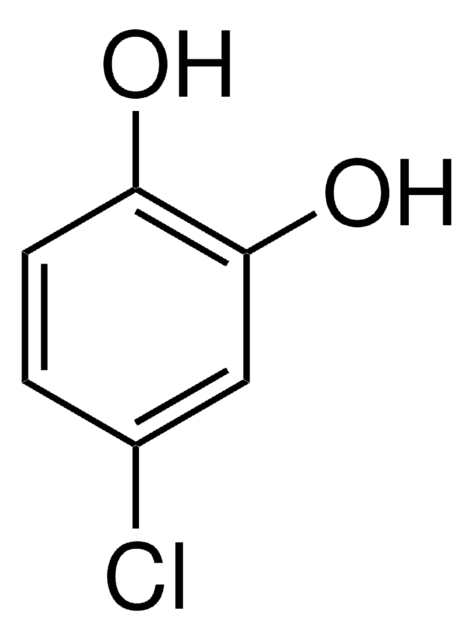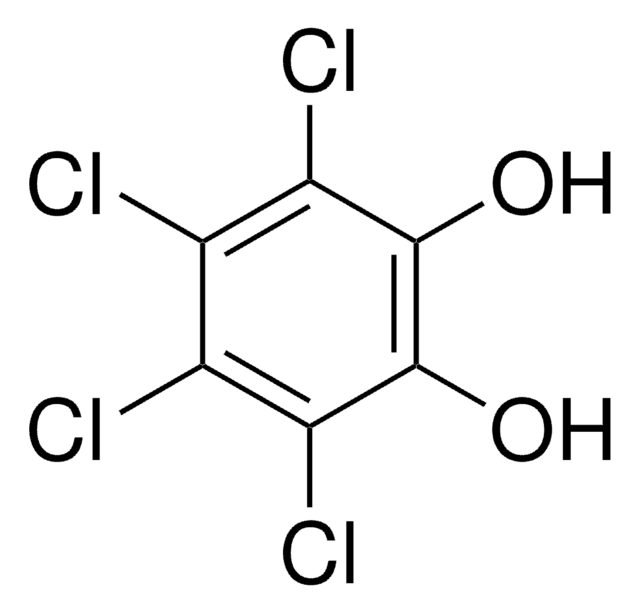480487
2,5-Dichlorohydroquinone
98%
Iniciar sesiónpara Ver la Fijación de precios por contrato y de la organización
About This Item
Fórmula lineal:
Cl2C6H2(OH)2
Número de CAS:
Peso molecular:
179.00
Número CE:
Número MDL:
Código UNSPSC:
12352100
ID de la sustancia en PubChem:
Productos recomendados
Ensayo
98%
mp
168-171 °C (lit.)
cadena SMILES
Oc1cc(Cl)c(O)cc1Cl
InChI
1S/C6H4Cl2O2/c7-3-1-5(9)4(8)2-6(3)10/h1-2,9-10H
Clave InChI
AYNPIRVEWMUJDE-UHFFFAOYSA-N
Descripción general
2,5-Dichlorohydroquinone (2,5-DCHQ) is a hydroquinone derivative that can be synthesized by reducing 2,5-dichloroquinone using sodium dithionite (Na2S2O4). The kinetics of the reaction of 2,5-DCHQ and N-phenyl-1,4-benzoquinonemonoimine has been studied. The transformation of 2,5-DCHQ to 2-chloromaleylacetate using PcpA (Pcp = pentachlorophenol) protein, isolated from Escherichia coli has been investigated. It is reported to be the degradation product of 2,4,5-trichlorophenoxyacetic acid and γ-hexachlorocyclohexane.
Palabra de señalización
Danger
Frases de peligro
Consejos de prudencia
Clasificaciones de peligro
Eye Dam. 1 - Skin Corr. 1B
Código de clase de almacenamiento
8A - Combustible corrosive hazardous materials
Clase de riesgo para el agua (WGK)
WGK 3
Punto de inflamabilidad (°F)
Not applicable
Punto de inflamabilidad (°C)
Not applicable
Equipo de protección personal
Eyeshields, Faceshields, Gloves, type P3 (EN 143) respirator cartridges
Elija entre una de las versiones más recientes:
¿Ya tiene este producto?
Encuentre la documentación para los productos que ha comprado recientemente en la Biblioteca de documentos.
K Miyauchi et al.
Journal of bacteriology, 180(6), 1354-1359 (1998-03-27)
Sphingomonas (formerly Pseudomonas) paucimobilis UT26 utilizes gamma-hexachlorocyclohexane (gamma-HCH), a halogenated organic insecticide, as a sole carbon and energy source. In a previous study, we showed that gamma-HCH is degraded to 2,5-dichlorohydroquinone (2,5-DCHQ) (Y. Nagata, R. Ohtomo, K. Miyauchi, M. Fukuda
Michael C Pirrung et al.
The Journal of organic chemistry, 67(23), 7919-7926 (2002-11-09)
Two total syntheses of the unsymmetrical bis-indolylquinone natural product demethylasterriquinone B1 (also known as L-783,281) have been accomplished. The first exploits a known base-promoted condensation of indoles with bromanil, which stops at monoaddition using the sterically hindered 2-isoprenylindole. This permits
C Klos et al.
Xenobiotica; the fate of foreign compounds in biological systems, 24(10), 965-976 (1994-10-01)
1. The metabolism of 1,4-dichlorobenzene has been studied in the male and female Fisher 344 rat over 72 h after oral administration of 14C-1,4-dichlorobenzene (900 mg = 96.8 microCi/kg). No covalent binding of radioactivity could be detected in samples of
S Oikawa et al.
Carcinogenesis, 17(12), 2733-2739 (1996-12-01)
p-Dichlorobenzene (p-DCB) has been reported to be carcinogenic for rodents, although it does not seem to be mutagenic in bacterial test systems. In this study, the mechanism of DNA damage by metabolites of p-DCB in the presence of metals was
Y Nagata et al.
Journal of bacteriology, 176(11), 3117-3125 (1994-06-01)
In Pseudomonas paucimobilis UT26, gamma-hexachlorocyclohexane (gamma-HCH) is converted to 2,5-dichloro-2,5-cyclohexadiene-1,4-diol (2,5-DDOL), which is then metabolized to 2,5-dichlorohydroquinone. Here, we isolated from the genomic library of UT26 two genes which expressed 2,5-DDOL dehydrogenase activity when they were transformed into P. putida
Nuestro equipo de científicos tiene experiencia en todas las áreas de investigación: Ciencias de la vida, Ciencia de los materiales, Síntesis química, Cromatografía, Analítica y muchas otras.
Póngase en contacto con el Servicio técnico









